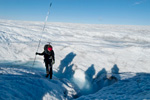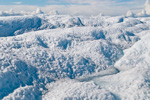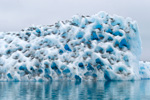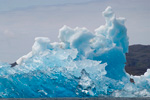In july 2010, I finally got up hiking on the Greenlandic ice sheet, in the Disco Bay area. Learning and getting to know it better, the origin of the icebergs, was a great experience! Think about it, it covers approx. 1,7 million square kilometers, covering roughly 80 % of the surface of Greenland. Being the second largest ice body in the world, after the Antartic ice sheet. Thickness is generally more than 2 km, some places over 3 km. The firm land under it is pressured down under sea level, like a bowl. Our guide, Ida, was doing a great job, taking care of our safety.
The landscape up on the ice sheet is more varied than I thought before, specially in the peripheral region, where there is much movement. These soft hills showed up in one area and we were extremely lucky with the weather this day.
The top 50 meters of the glacier, being under less pressure, are more rigid; this section is known as the fracture zone, and mostly moves as a single unit, over the plastic-like flow of the lower section. When the glacier moves through irregular terrain, cracks up to 50 meters deep form in the fracture zone. The lower layers of glacial ice flow and deform plastically under the pressure, allowing the glacier as a whole to move slowly like a viscous fluid. The upper layers of glaciers are more brittle, and often form deep cracks known as crevasses. They form due to differences in glacier velocity. As the parts move at different speeds and directions,shear forces cause the two sections to break apart, opening the crack of a crevasse all along the disconnecting faces.
In Kangerlussaq you can also get very close to the edge of the ice sheet (don´t go too close...). Here the rocks are also beautiful with patterns mirroring the ice, with a meltwater river running by.
Cryoconit holes are a water filled cylindrical melt-holes on glacial ice surface. It has been reported from glaciers in many parts of the world. At bottom of the cryoconite holes, dark colored material called cryoconit is deposited. That is mineral and organic dust that comes from the atmosphere, with the wind. As the cryoconite absorbs solar radiation and promotes melting of the ice beneath it, the cylindrical holes are formed. They have been suggested to play important roles in the glacier ecosystems because many kinds of living organisms have been reported from this structure on the glaciers, for example algae, rotifer, tardriga, insects and ice worm.
The glacier ice, coming from the ice sheet that covers most of Greenland, continous to fascinate me with its infinit variations.The biggest ones are up in Disco Bay, in Ilulissat icefjord. In the south, they are smaller but with most beautiful foms and colors.This picture of a small, crystal clear, iceberg is taken in south Greenland, in summer 2005. Blue ice occurs when snow falls on a glacier, is compressed, and becomes part of a glacier that winds its way toward a body of water (river, lake, ocean, etc.). During its travels, air bubbles that are trapped in the ice are squeezed out, and the size of the ice crystals increases, making it clear. The blue color is often wrongly attributed to Rayleigh scattering. Rather, ice is blue for the same reason water is blue: it is a result of an overtone of an oxygen-hydrogen (O-H) bond stretch in water which absorbs light at the red end of the visible spectrum.
Images 1-3 are taken up on the Greenlandic ice sheet. in the Disco Bay area, summer 2010.
Images 4 are taken beside the Greenlandic ice sheet. in the Kangerlussuaq area, summer 2010.
Images 5-8 are taken from a boat in south Greenland, summer 2004-2009.
© 2011 Eva Johnson/NordArc All rights reserved.





